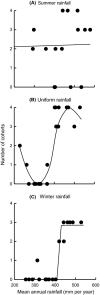Demographic patterns of a widespread long-lived tree are associated with rainfall and disturbances along rainfall gradients in SE Australia
- PMID: 23919160
- PMCID: PMC3728955
- DOI: 10.1002/ece3.626
Demographic patterns of a widespread long-lived tree are associated with rainfall and disturbances along rainfall gradients in SE Australia
Abstract
Predicting species distributions with changing climate has often relied on climatic variables, but increasingly there is recognition that disturbance regimes should also be included in distribution models. We examined how changes in rainfall and disturbances along climatic gradients determined demographic patterns in a widespread and long-lived tree species, Callitris glaucophylla in SE Australia. We examined recruitment since 1950 in relation to annual (200-600 mm) and seasonal (summer, uniform, winter) rainfall gradients, edaphic factors (topography), and disturbance regimes (vertebrate grazing [tenure and species], fire). A switch from recruitment success to failure occurred at 405 mm mean annual rainfall, coincident with a change in grazing regime. Recruitment was lowest on farms with rabbits below 405 mm rainfall (mean = 0-0.89 cohorts) and highest on less-disturbed tenures with no rabbits above 405 mm rainfall (mean = 3.25 cohorts). Moderate levels of recruitment occurred where farms had no rabbits or less disturbed tenures had rabbits above and below 405 mm rainfall (mean = 1.71-1.77 cohorts). These results show that low annual rainfall and high levels of introduced grazing has led to aging, contracting populations, while higher annual rainfall with low levels of grazing has led to younger, expanding populations. This study demonstrates how demographic patterns vary with rainfall and spatial variations in disturbances, which are linked in complex ways to climatic gradients. Predicting changes in tree distribution with climate change requires knowledge of how rainfall and key disturbances (tenure, vertebrate grazing) will shift along climatic gradients.
Keywords: Callitris; climatic gradients; demography; disturbances; grazing; tree distribution.
Figures







References
-
- Araújo MB, New M. Ensemble forecasting of species distributions. Trends Ecol. Evol. 2007;22:42–47. - PubMed
-
- Auld TD. The impact of herbivores on regeneration in four trees from arid Australia. Rangeland J. 1995;17:213–227.
-
- Auld TD, Denham AJ. Flora conservation issues at Kinchega National Park, western NSW. Cunninghamia. 2001;7:27–40.
-
- Auld TD, Keith DA. Dealing with threats: integrating science and management. Ecol. Manage. Restor. 2009;10:s79–s87.
-
- Austin MP, Williams OB. Influence of climate and community composition on the population demography of pasture species in semi-arid Australia. Vegetatio. 1988;77:43–49.
LinkOut - more resources
Full Text Sources
Other Literature Sources

